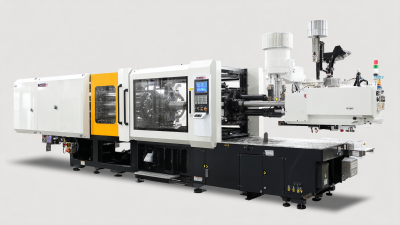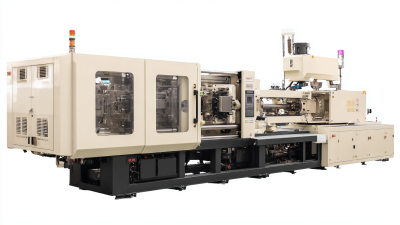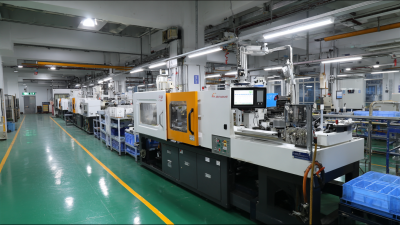Exploring the Comparative Benefits of Different Injection Molding Machine Types
The landscape of injection molding technology has evolved significantly over the years, leading to the emergence of various types of injection molding machine tailored to meet specific manufacturing needs. According to a report by MarketsandMarkets, the global injection molding machine market is projected to reach USD 10.87 billion by 2025, growing at a CAGR of 4.7% during the forecast period. This growth is primarily driven by the increasing demand for lightweight and durable components across multiple industries, including automotive, consumer goods, and electronics.

Each type of injection molding machine—whether hydraulic, electric, or hybrid—presents unique advantages that can influence the efficiency, accuracy, and cost-effectiveness of production processes. In this blog, we will explore and compare these different types of injection molding machines, highlighting their respective benefits and applications to provide a comprehensive guide for manufacturers looking to optimize their operations.
The Evolution of Injection Molding Machine Technology and Its Impacts on Production Efficiency
The evolution of injection molding machine technology has significantly impacted production efficiency across various industries. As manufacturers strive to enhance product quality, the development of adaptive adjustment systems becomes crucial. These systems can dynamically modify parameters during the manufacturing process, ensuring optimal conditions are maintained and reducing the likelihood of defects. This adaptive approach not only increases the quality of the final product but also minimizes waste and downtime.
Tips: When implementing new technologies in injection molding, consider conducting thorough training sessions for operators to familiarize them with advanced systems. Moreover, regular maintenance of machinery is essential to sustain high efficiency levels and prolong the lifespan of the equipment.
Furthermore, the integration of advanced mechatronic systems into the production process aligns with the principles of Industry 4.0, where digital technologies converge with physical manufacturing systems. This synergy not only boosts automation but also enhances data collection, allowing for better-informed decision-making and process optimization.
Tips: Investing in smart sensors and real-time monitoring tools can provide valuable insights into production performance, helping identify areas for improvement and driving overall efficiency.
Comparing Hydraulic, Electric, and Hybrid Injection Molding Machines: A Data-Driven Analysis
Injection molding is a vital process in manufacturing, and choosing the right type of machine can significantly impact production efficiency and part quality. In a recent analysis, data reveals that hydraulic injection molding machines dominate the market with over 60% share, largely due to their robustness and lower initial costs. However, electric injection molding machines are gaining traction, with a projected growth rate of 8% annually. This is largely attributed to their energy efficiency, offering up to 70% energy savings compared to hydraulic models, as stated in a report by the Plastics Industry Association.
Hybrid injection molding machines combine the advantages of both hydraulic and electric technologies. The latest data shows that hybrid systems can achieve a 15% increase in cycle time efficiency while maintaining the versatility of hydraulic machines. Additionally, they contribute to reduced carbon emissions, aligning with sustainability goals that many manufacturers are now pursuing.
**Tip:** When selecting an injection molding machine, consider the specific requirements of your products. If precision and energy efficiency are paramount, an electric machine might be the best choice. Conversely, if you require high-speed production and lower setup costs, a hydraulic model could be more suitable. Always examine the long-term operational costs versus initial investments to make an informed decision.
Exploring the Comparative Benefits of Different Injection Molding Machine Types
| Machine Type | Energy Efficiency (%) | Cycle Time (seconds) | Initial Cost ($) | Maintenance Cost ($/year) | Production Volume (units/hour) |
|---|---|---|---|---|---|
| Hydraulic | 70 | 15 | 50,000 | 5,000 | 150 |
| Electric | 90 | 10 | 65,000 | 3,000 | 200 |
| Hybrid | 85 | 12 | 60,000 | 4,000 | 180 |
Cost Efficiency: Analyzing Operational Costs Across Different Injection Molding Machine Types
When evaluating the cost efficiency of different injection molding machine types, it's essential to consider not just the initial investment but ongoing operational costs as well. According to a recent report by MarketsandMarkets, companies can see operational savings of up to 30% when they choose hydraulic machines over electric models under specific production conditions. This is largely due to the lower energy consumption and maintenance expenses associated with hydraulic machines, making them a preferred choice for high-volume production runs.
However, electric injection molding machines are gaining traction for their efficiency and precision. A study by Grand View Research indicates that electric machines can reduce energy usage by approximately 70% compared to hydraulic options during standard operations. This shift not only helps businesses cut costs but also aligns with environmentally sustainable practices, which is increasingly important in today's market.
**Tips:** When selecting an injection molding machine, evaluate the total cost of ownership, including energy consumption, maintenance, and expected lifespan. Consider running tests with both machine types to determine which provides the optimal balance between upfront costs and long-term savings for your specific production needs. Additionally, factor in the potential for increased product quality and consistency, which can lead to further cost reductions over time.
Cost Efficiency of Different Injection Molding Machine Types
This chart illustrates the operational costs associated with different types of injection molding machines. Hydraulic machines exhibit the highest operational costs, while electric machines are the most cost-efficient, followed by hybrid machines.
Environmental Considerations: How Machine Type Influences Energy Consumption and Sustainability
The choice of injection molding machine plays a critical role in energy consumption and overall sustainability in manufacturing processes. Hydraulic machines, while traditionally reliable and powerful, often consume significant amounts of energy and can lead to higher operational costs. In contrast, electric injection molding machines, which utilize servo motors to optimize energy use, present a more sustainable option. By only drawing power when needed, these machines can reduce energy consumption by up to 80%, making them an attractive choice for environmentally conscious manufacturers.
Furthermore, the design and construction of a machine can impact not only energy efficiency but also waste generation. For example, hybrid machines combine elements of both hydraulic and electric systems, offering a balance of performance and sustainability. These machines often allow for faster cycle times and better precision, which can reduce material waste. As awareness of environmental issues grows, manufacturers are increasingly prioritizing equipment that minimizes their ecological footprint, aligning production practices with sustainable growth goals. The evolution of injection molding technology thus presents a significant opportunity to enhance the sustainability of production processes across various industries.

Future Trends in Injection Molding: Innovations to Watch in Machine Design and Functionality
In the realm of injection molding, the future holds promise with several innovative trends shaping machine design and functionality. One significant development is the integration of Industry 4.0 principles, which leverages the Internet of Things (IoT) for real-time monitoring of machine performance. According to a report by Mordor Intelligence, the global smart injection molding machine market is expected to grow at a CAGR of 12.1% from 2023 to 2028, driven largely by demand for enhanced efficiency and reduced downtime.
Another exciting trend is the move towards more sustainable practices in injection molding, with manufacturers increasingly adopting energy-efficient machines and biodegradable materials. The Plastics Industry Association estimates that transitioning to these eco-friendly machines could reduce energy consumption in the injection molding process by up to 30%. Furthermore, advancements in machine design, such as the implementation of servo-driven systems, are improving precision and reducing cycle times, thereby enhancing overall productivity and sustainability. These innovations not only address current environmental concerns but also align with the industry's push for greater operational efficiency.

Related Posts
-

How to Choose the Best Home Plastic Injection Molding Machine for Your DIY Projects
-

Evaluating the Best Large Injection Molding Machines for Global Buyers in 2025 Industry Trends and Insights
-

Maximizing Production Efficiency with Advanced Plastic Molding Machines
-

Comparing Efficiency and Cost: Mini Plastic Injection Molding Machines Vs. Traditional Methods
-

Ultimate Injection Machine Comparison for Optimal Performance Selection
-

Exploring Innovative Alternatives to Plastic Injection Machines for Modern Manufacturing
